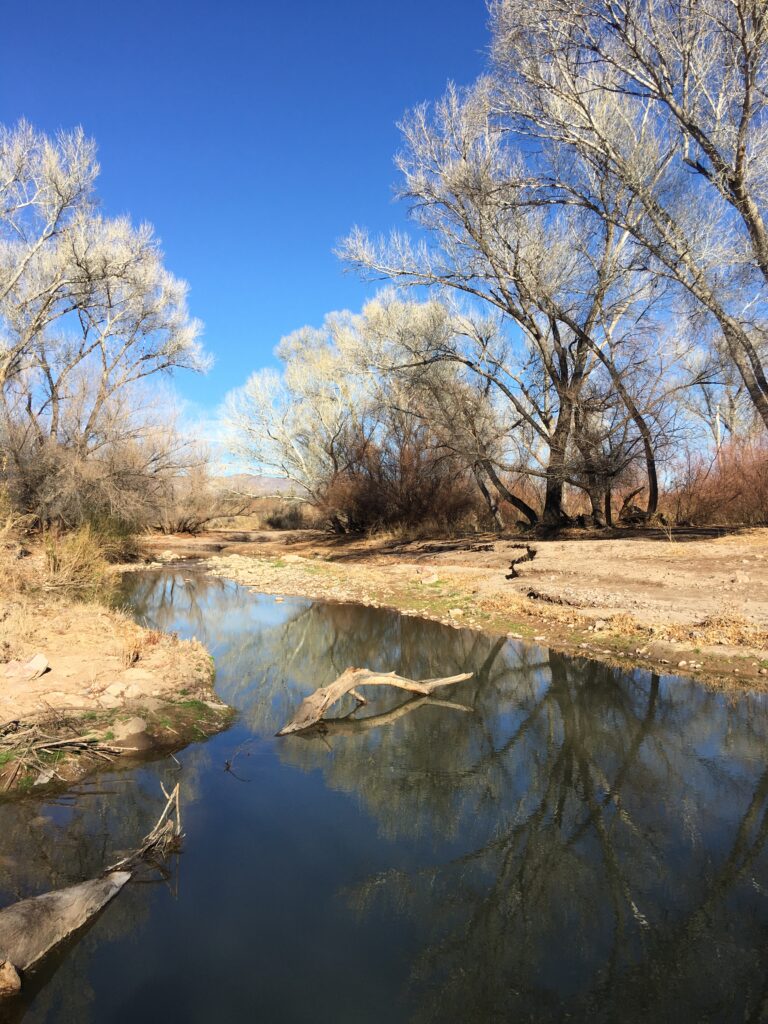
The Aravaipa Creek is part of the Lower San Pedro Watershed area. Photo by T.C. Brown
The Mammoth Community Center was the place to be on Feb. 11, 2025. Attendees learned from the Lower San Pedro Watershed Alliance (LSPWA) group about the organization’s considerable efforts over the past 13 years to safeguard the Lower San Pedro River’s water resources and its unique riparian bio-habitat. Partner groups, including Cascabel Conservation Association, Center for Biological Diversity, Save the Scenic Santa Ritas and Arizona Mining Reform Coalition shared challenges and lessons learned in addressing similar industrial threats with the several attendees. A great deal of information, maybe too much at once, was presented during the almost 2-hour session. Many of the attendees were members and supporters of the groups represented whom were already in agreement with their ideas or missions.
Peter Else with the Lower San Pedro Watershed Alliance (LSPWA) led off the presentation. He discussed the San Pedro Watershed and its proximity to the development corridor, also referred to as the Sun Corridor. This refers to the “area of the state stretching from Nogales in the south to the Flagstaff area in the north, with Phoenix and Tucson at its core.” Also discussed was the idea that “the area connects four mountain ranges as well as the second largest block of unfragmented wildlands in AZ and NM.”
LSPWA thoughts were presented on multiple other topics to include: the lawsuit against oversight agencies for SunZia’s unwarranted decision to construct giant transmission towers along the most remote and ecologically sensitive portion of the San Pedro watershed, rather than using existing infrastructure corridors; regarding plans by Redhawk Copper, Inc. (owned by the Canadian corporation Faraday Copper) to build a series of six new open-pit mines and two block-cave mines at Copper Creek, a tributary of the San Pedro River; and response to a recent Air Force proposal to conduct subsonic and supersonic, low-altitude flight-training exercises over the lower San Pedro River and other parts of our state’s most remote and ecologically pristine wilderness areas.
Some of the other points addressed by the LSPWA include the following: “The San Pedro River represents the second-largest tract of unfragmented land in Arizona, second only to the Grand Canyon.”
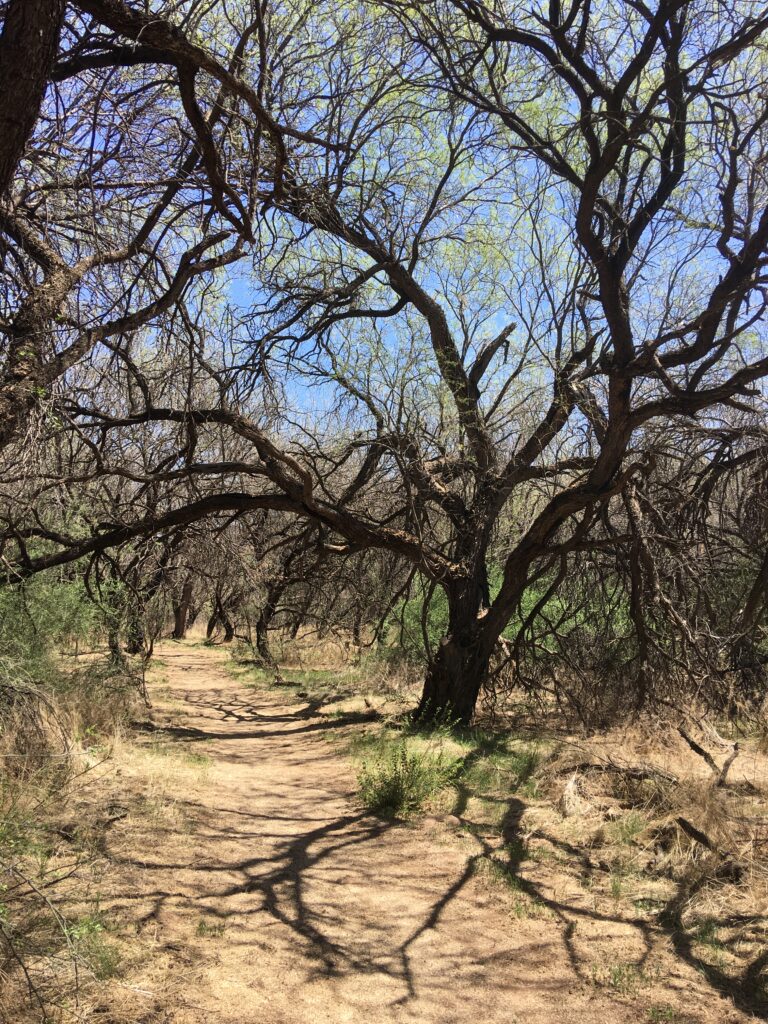
7B Ranch Nature Trail is located due east of the town of Mammoth and is a popular birding area. Photo by T. C. Brown
“The fenced-off area along River Road/the river-crossing from Mammoth’s Bluebird road (leading to Copper Creek Road) where the 7B walking trail is, is due to Resolution Copper’s land swap. It is owned by them and includes more than 3000 acres of land due to its unique habitat and biodiversity. 23:01 (We’ve heard locals assuming The Nature Conservancy came in and bought that property off to ‘keep locals out.’ TNC was only a partner in setting up the trails, along with Audubon. That area is recognized as a globally Important Bird Area as well, which is a pretty big deal). It is also to become part of the larger San Pedro Riparian National Conservation Area (SPRNCA). With Faraday potentially opening a 28-square-mile open pit mine upslope of that area, the 7B area may be seriously degraded, because… The impact of drilling in the mountains will have a negative impact on the subsurface water levels down by the San Pedro due to the geology of the area (i.e., also the wells of residents in Mammoth).”
“The mission of the Lower San Pedro Watershed Alliance is to protect the ecological integrity and associated indigenous cultural heritage of the lower San Pedro region of Arizona, primarily through voluntary and effective actions by local citizens.” More information on the LSPWA can be found on their website at https://www.lowersanpedro.org.
Rob Peters from Save the Santa Ritas, located south of Tucson, was the next presenter. He discussed his groups ongoing opposition to the Copper World Project by the Canadian company Hudbay. He indicated that “Big Mining’s Game Plan” included ideas such as: “Exaggerate economic benefits and downplay economic harm; Downplay the health consequences; Take advantage of weak state environmental oversight; and Make economic deals with some sections of the community to turn citizens against citizens.” Corporate “Claims” and grassroot group “Realities” were presented. He went on to discuss state and federal agency bias and agency weaknesses when it comes to the mining industry. Organizing, fundraising, finding experts, and coalition building were encouraged to fight industrial encroachment of the natural world around us.
Save the Scenic Santa Ritas Mission statement: We protect the scenic, aesthetic, recreational, environmental and wildlife values of the Santa Rita Mountains through education and outreach, including protection of these areas from degradation due to mining activities. See more at https://www.scenicsantaritas.org.
Chris Eastoe, a retired University of Arizona Scientist, gave a very academic presentation to the attendees. His main points included: An introduction to the Cascabel Conservation Association; Progressive drying of our region; and How aquifers in the San Pedro Valley function in great detail. He also discussed initial successes and suggestions ignored during the earlier phases of the SunZia powerline project. He indicated that the Copper Creek mining project would need to pump large volumes of water out of the San Pedro Watershed resulting in lowered aquifer levels.
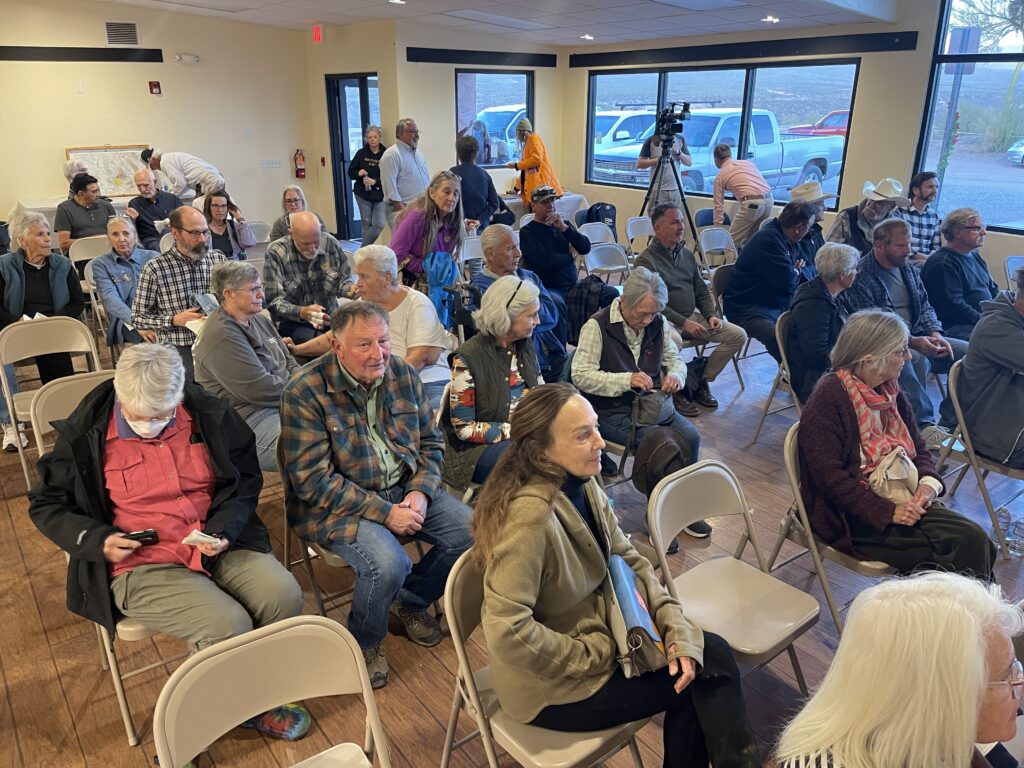
Community members, group supporters and Phoenix Media were on hand for the Lower San Pedro Watershed Alliance address. Photo by T. C. Brown
“The Cascabel Conservation Association is dedicated to the collaborative stewardship of the Middle San Pedro River watershed in a way that promotes the health, stability and diversity of the whole community, including its earth, waters, plants, and animals. We strive to integrate the needs of the land with the needs of a sustainable human community through educational, economic, agricultural, contemplative and other conservation related endeavors.” Additional information can be found at https://cascabelconservation.org.
Russ McFadden presented on behalf of the Center for Biological Diversity. He discussed: The Center and its mission; The Center’s Southwest Program; and His role and experience in the field.” He discussed the Lower San Pedro River Valley being a lifeline for wildlife, including migratory birds, endangered species and biodiversity. He described the area as being a center for community and culture, referring to the Native Americans cultural landscape, along with rural communities, farming and recreation.
Challenges presented for the area include: the Sunzia Transmission Line impacts on desert ecosystems, habitat fragmentation, and bird strikes; Air force Supersonic Flight noise pollution, disruption to wildlife, and increased military activity; Faraday Copper Mine water depletion, toxic runoff risks, habitat destruction, pollution and air quality; along with concerns for the climate, water extraction and development.
Further discussed were how the Center works with communities, local opposition being key, success stories and a call to action for attendees to get involved to protect the area from perceived threats to the communities and natural world around them.
“At the Center for Biological Diversity, we believe that the welfare of human beings is deeply linked to nature — to the existence in our world of a vast diversity of wild animals and plants. Because diversity has intrinsic value, and because its loss impoverishes society, we work to secure a future for all species, great and small, hovering on the brink of extinction. We do so through science, law and creative media, with a focus on protecting the lands, waters and climate that species need to survive.” See more at https://www.biologicaldiversity.org/about/.
Roger Featherstone with the Arizona Mining Reform Coalition was the last to present. He discussed several concerns and ideas. Some of them include: Lack of enough water for communities and environment to share with inappropriate mines, water exportation, ongoing severe drought, continuing poor mining practices, poor government oversight, need for revised state and federal mining laws, copper exportation, and environmental degradation for continued mine exploration.
He discussed opinions of the lack of update to the 1872 Mining Law, lack of royalty payments from mining companies for the minerals they take, mining being the number one source of toxic pollution and poor mining processes prior to, during and after mining operations; economics of mining vs outdoor recreation; mining strategies; community activism; and more.
“The Arizona Mining Reform Coalition is comprised of Arizona groups and individuals that work to ensure that responsible mining contributes to healthy communities, a healthy environment, and, when all costs are factored in, is a net benefit to Arizona. The Arizona Mining Reform Coalition expects the mining industry to clean up after itself, comply fully with the spirit of safeguards in place to protect Arizona, and to interact in a transparent and open manner with Arizona citizens.”
The group further states: Mining is an inappropriate use of some lands in Arizona; State and federal mining laws need to be positively reformed; the coalition will promote alternative uses of some mineral deposits; and the coalition will increase awareness of all aspects of mining in Arizona. See more at https://azminingreform.org.
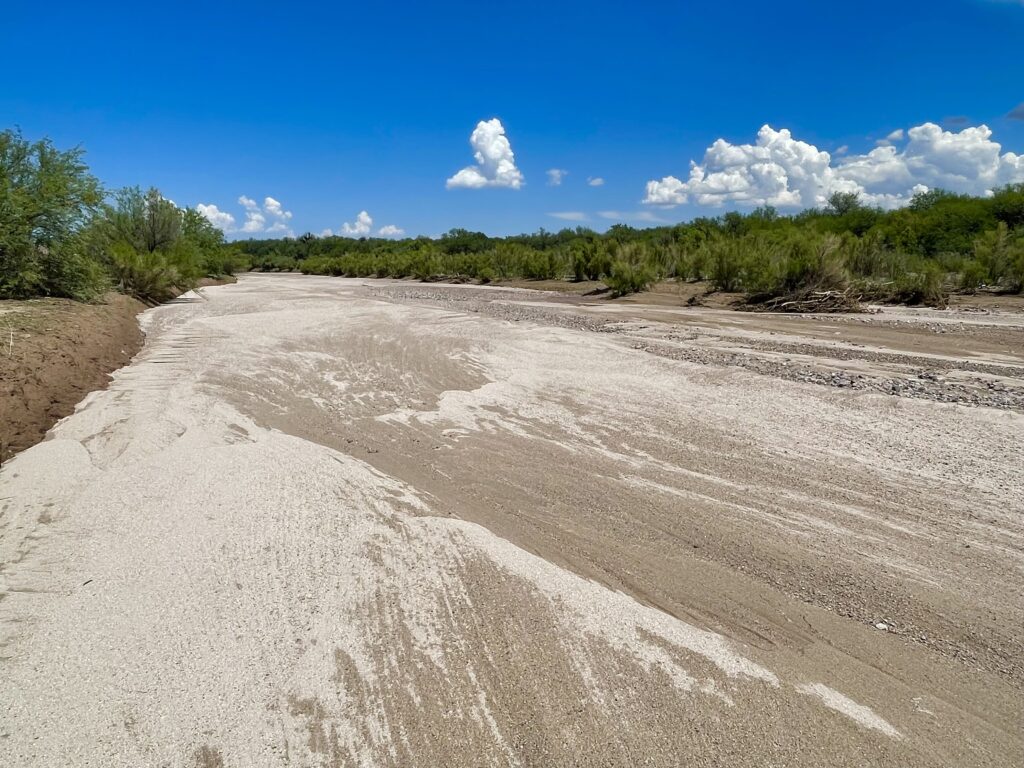
The San Pedro River runs south to north through the Mammoth area and is often dry at the surface. Photo by T.C. Brown
The Lower San Pedro River covers the area north of Benson to the confluence with the Gila River near Winkelman. As it is now known, “The San Pedro Riparian National Conservation Area (NCA) contains almost 57,000 acres of public land in Cochise County, Arizona, between the international border and St. David, Arizona. Congress designated the riparian area as a Riparian National Conservation Area on Nov. 18, 1988. Some 40 miles of the upper San Pedro River meanders through the area.” The Lower San Pedro River is not presently part of this BLM area. More information from BLM can be seen at https://www.blm.gov/national-conservation-lands/arizona/san-pedro.
“The Department of the Air Force (DAF1) is proposing to alleviate training shortfalls and address evolving training needs for aircrews stationed at Davis-Monthan Air Force Base (AFB), Luke AFB, and Morris Air National Guard Base (ANGB) in Arizona by requesting that the Federal Aviation Administration (FAA) implement modifications to existing DAF-managed Military Operations Areas (MOAs2), which are a type of Special Use Airspace (SUA), and associated Air Traffic Control Assigned Airspace (ATCAA). The bases in Arizona share a primary mission to train and deploy combat-ready pilots for the Air Force, Air National Guard (ANG), and Air Force Reserves, thus the DAF-managed MOAs in this region must support training for a variety of aircraft and missions. Much of the DAF-managed MOAs available to aircrews in this region were first charted decades ago and minimal improvements have been made over time in response to changes to the DAF aircraft inventory, new training requirements, or expanded missions. Thus, there is a need to optimize existing MOAs and ATCAAs by modifying the published times of use, volume, minimum altitude for supersonic flight, use of chaff, and lowering the release altitude for flares to ensure availability of appropriate airspace to accomplish essential training requirements for aircrews stationed in Arizona.”
Cooperating agencies include the Department of the Air Force (DAF), Federal Aviation Administration (FAA), National Park Service (NPS), U.S. Forest Service (USFS), and Arizona Game and Fish Department (AZGFD). A copy of the EIS can be found at https://www.arizonaregionalairspaceeis.com/media/5zuprqlw/public-draft-eis_main-document.pdf.
Copper is not presently recognized as essential by the U.S. Geological Survey. In 2023, the “U.S. Department of Energy (DOE) added copper to its list of critical materials in the medium term due to projected demands as the U.S. shifts towards cleaner energy sources such as solar and wind. Copper’s addition to this list makes it eligible for government subsidies under the Inflation Reduction Act.”https://www.generalkinematics.com/blog/copper-critical-mineral/
What was not discussed during the presentation was alternative land uses that might be utilized as opposed to proposed industrial uses. There was also no mention of ideas to assist the communities economically that lie along the Lower San Pedro River. Representatives from the Town of Mammoth, tribal lands and others mentioned as being at risk ecologically and economically by a number of the projects were not on hand to discuss any potential concerns.
A GovTech blog has this interesting explanation.
“Most of us have heard of NIMBY (Not in My Backyard), which alludes to having things like power lines and pipelines being built near neighborhoods or businesses. The other day I heard a new one, BANANA (Build Absolutely Nothing Anywhere Near Anyone).
“It seems that everyone wants to have electricity for all their personal and business needs, natural gas to heat their homes or gasoline to fuel their cars, trucks and boats, yet no one wants the infrastructure to support the delivery of those essential utilities and supplies that fuel our modern economy.” https://www.govtech.com/em/emergency-blogs/disaster-zone/there-is-nimby-and-now-there-is-banana.html
Community members are encouraged to research these important topics on their own. Each of us has our thoughts, ideas and opinions. Robert Evans — ‘There are three sides to every story: your side, my side, and the truth. And no one is lying. Memories shared serve each differently.’
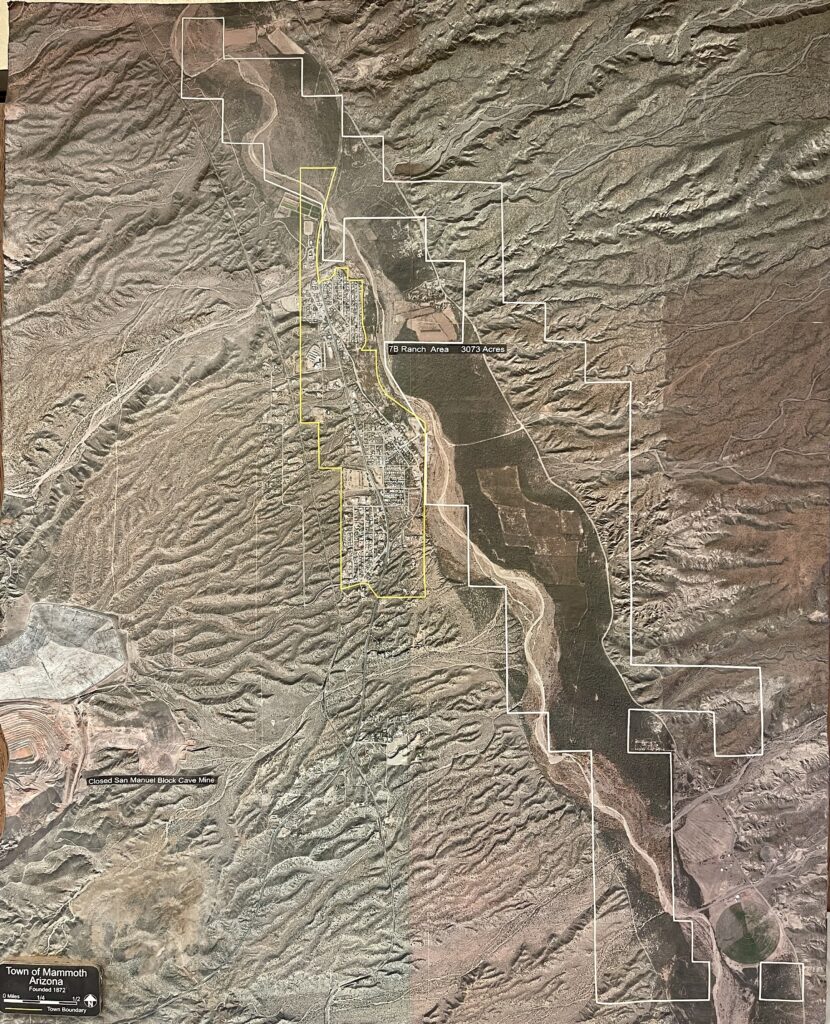
The Town of Mammoth and areas surrounding it are consumers of water in the Lower San Pedro Watershed.
